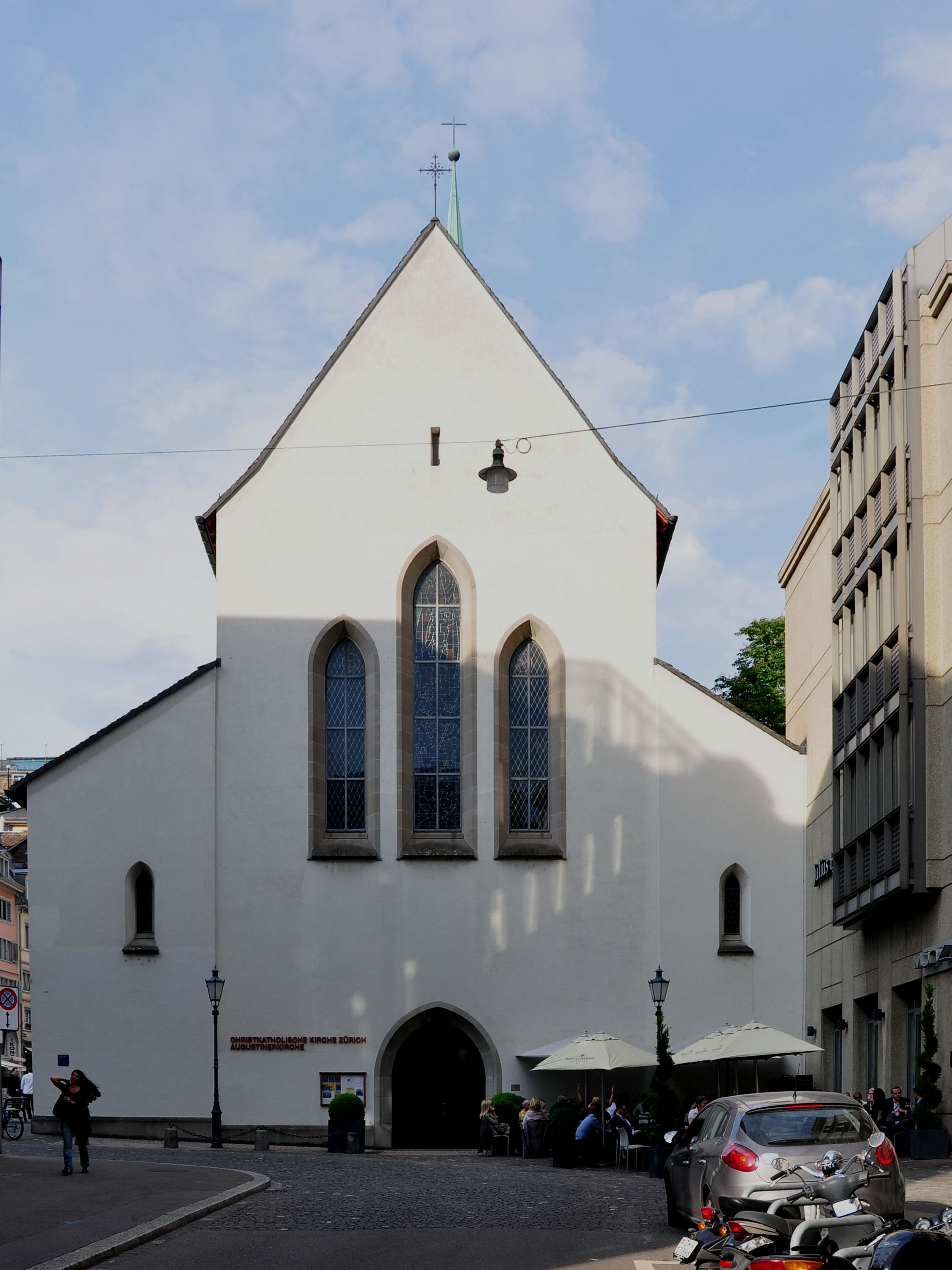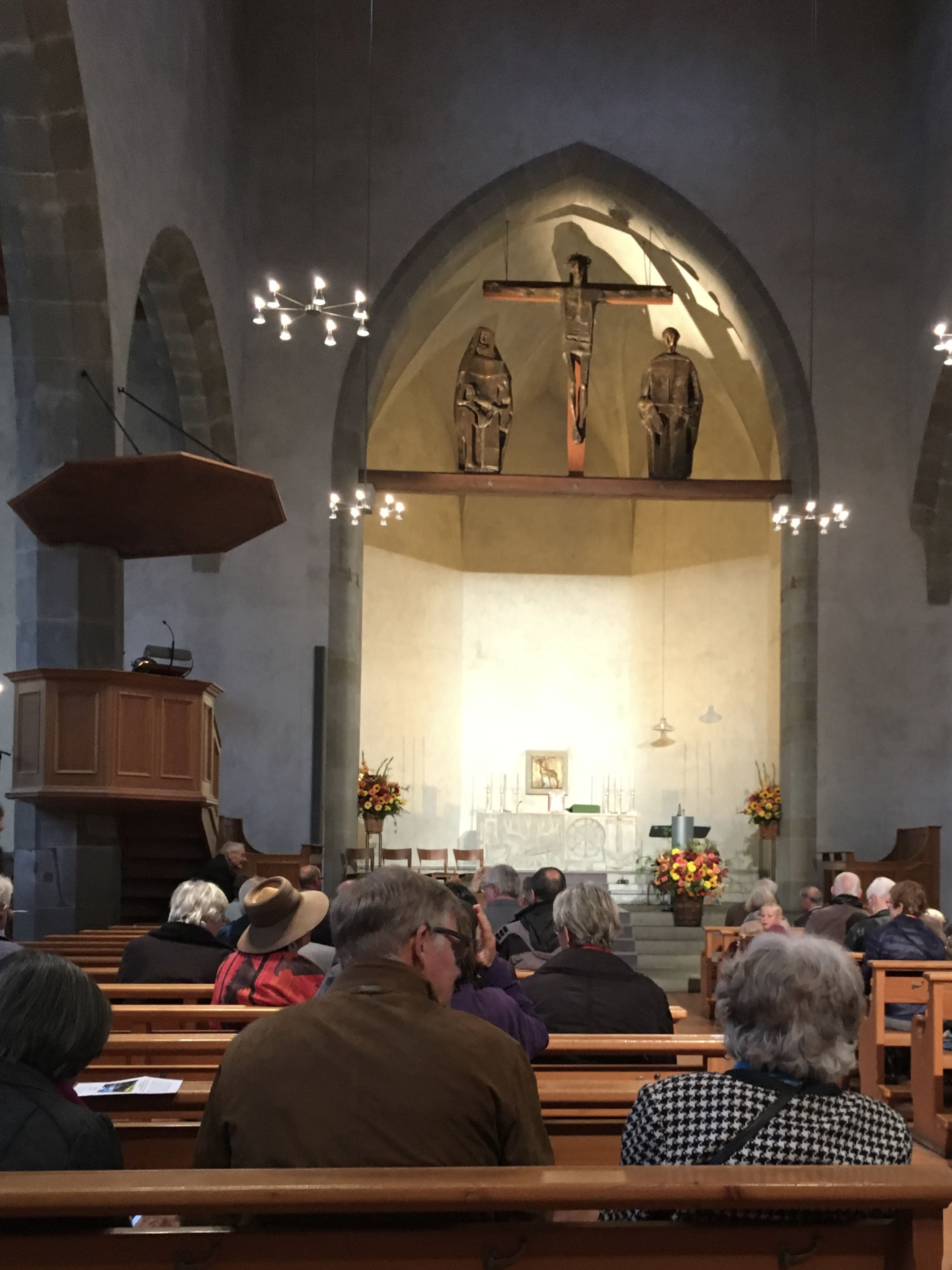| |
 |
 |
 |
| Comment on this report, or find other reports. |
 |
| Our Mystery Worshippers are volunteers who warm church pews for us around the world. If you'd like to become a Mystery Worshipper, start here. |
 |
| Find out how to reproduce this report in your church magazine or website. |
|
|
| 3246: Augustinerkirche, Zürich, Switzerland |
 |

Photo:
© Roland zh and used under license
|
 |
Mystery Worshipper: Columba's Currach.
The church: Augustinerkirche, Zürich, Switzerland.
Denomination: Christian Catholic Church of Switzerland, the Swiss member church of the Union of Utrecht of Old Catholic Churches.
The building: A church was first built on this site in 1270. As the name implies, it was served by Augustinian friars. However, after the Swiss Reformation led by Huldrych Zwingli, worship was discontinued and the building fell to use as a mint, a storehouse, and a wine press. It was rebuilt in 1843 by the 19th century Swiss architect Ferdinand Stadler, whose other commissions include the Anglican cathedral in Nazareth. Further restoration was done in the late 1950s, at which time many of Stadler's additions were removed, bringing the building back to its original design. The stained glass dates from 1965. The interior is notable for its dramatic rood. It also has both an enormous pulpit of the sort I would associate with Reformed churches and a prominent stone altar with six candles and a tabernacle. It struck me that the combination of these two may been a deliberate claim by the Christian Catholic community to focus as much on preaching as the Protestants and as much on the sacraments as Roman Catholics.
The church: The Christian Catholic Church is the church of about 2.5 per cent of the population of Switzerland, heavily concentrated in the German-speaking cantons. It was founded in the aftermath of the First Vatican Council by Swiss Catholics who were opposed to the concept of papal infallibility. They have several services, concerts, and other events each week.
The Christian Catholic Church ordains both men and women, and three of the five priests servicing the Zürich parish are women. This is perhaps the most visible difference between them and their Roman Catholic neighbours.
The neighbourhood: Zürich, which the ancient Romans called Turicum, is Switzerland's largest city. It has been consistently ranked among the top ten most livable cities in the world, with one of the best qualities of life, and also one of the wealthiest (Roman Turicum was a tax-collecting hub). German is the official language of Zürich; other languages, in order of popularity, are English, Italian and French, with a smattering of Croatian, Serbian, Spanish, Portuguese and Albanian. The stereotypes about central Zürich are entirely true: it is indeed very clean and filled with shops selling very expensive wristwatches.
The cast: The celebrant and preacher was Pfarrer Frank Bangerter, one of the priests of the parish and also the president of Zürich Centre for Christian Catholic Theology. There was also a welcome from Urs Stoltz, the Kirchenpflegepräsident (roughly a churchwarden or chairman of the church council). Pfrarrer Bangerter was assisted by three altar servers who seemed to be between the ages of nine and sixteen, and by an adult lector who read the first lesson and the intercessions. The music was provided by the Jodlerchörl Geuensee, with Beatrice Meier at the organ.
The date & time: Sunday, 22 October 2017, 10.00am.
What was the name of the service?
Jodlermesse (Yodeling Mass).
How full was the building?
The central nave was quite full, but the aisles were entirely empty. All in all, I think there were perhaps 200 people there.
Did anyone welcome you personally?
An adolescent girl in a cassock alb smiled and said "Grüezi" (a Swiss German greeting) to me when she handed me order of service.
Was your pew comfortable?
It was fine, although I was glad we didn't have to use the kneelers, as they looked rather uncomfortable.
How would you describe the pre-service
atmosphere?
The service was being broadcast on television and radio, so there was a lot of activity on that front, although the congregation were mostly pretty quiet.
What were the exact opening words of the
service?
After the entrance procession, which was done to a wordless yodel, the Kirchenpflegepräsident gave a little speech of welcome. I believe the exact first words were "Liebe Freunde und liebe Gäste" (dear friends and dear guests). The first liturgical words, spoken by Pfrarrer Bangerter, were "Im Namen des Vaters und des Sohnes und des Heiligen Geistes."
What books did the congregation use during the
service?
A bespoke service booklet, which contained the words of the liturgy and the songs sung by the yodeling choir. There were no congregational hymns at this service.
What musical instruments were played?
A fine pipe organ, an opus of Orgelbau Th. Kuhn AG of Männedorf, Switzerland, installed in 1959, was played both to accompany the choir and as a solo instrument.
Did anything distract you?
Leaving aside the obvious factor of never having been to a mass with yodeling before, I was a little distracted by camera crews filming the service. I was also amused by the difference in appearance between the Kirchenpflegepräsident and the priest when the two stood together. The former looked like a quintessential banker with a suit and neatly trimmed grey hair. The priest, on the other hand, was wearing both rather strikingly modern green vestments and a ponytail.

Was the worship stiff-upper-lip, happy clappy, or
what?
With the exception of the music, it was virtually identical to what one would find in most mainstream modern Roman Catholic parishes. It was probably a bit lower than most Anglo-Catholic parishes, but rather higher than most low-church Anglican parishes.
The priest wore a chasuble and made manual actions in all the right places, but didn't chant. The three servers wore cassock albs. There was a procession with lights to ambo for the gospel. There were bells but no incense.
Exactly how long was the sermon?
8 minutes.
On a scale of 1-10, how good was the preacher?
6 – The priest seemed warm and likable, but my German wasn't good enough to follow everything he said. He did preach from the ambo, which I suspect is now normal if not universal practice, but it seemed a shame not to use the massive and splendid pulpit.
In a nutshell, what was the sermon
about?
I could only tell that it was a commentary on the gospel for the day ("render unto Caesar") with a comment about the social duties of Christians.
Which part of the service was like being in
heaven?
Surprisingly enough, the yodeling. I'm afraid I'd known this sort of music only as the butt of jokes, but it was absolutely beautiful sung by a skilled choir. They sang paraphrases of the mass texts in colloquial Swiss German, plus several motets.
The way the intercessions were handled was also striking.
And which part was like being in... er... the other place?
One eccentricity that struck me as rather unfortunate concerned the distribution of communion. The first two rows of the congregation went forward to receive in two groups with a rather formal ceremony that involved standing in a semi-circle around the altar and bowing in unison before and after receiving. Then the distribution stopped before most of the congregation was able to receive. I was able to understand enough to realize that everyone else could receive the consecrated elements after the service. I had never seen this before, and wondered if it was done because the service was being filmed. In any case, it struck me as a fairly poor way of handling the issue.
What happened when you hung around after the service looking lost?
No one paid me any attention. I think Zurichers are a rather reserved lot.
How would you describe the after-service
coffee?
As far as I know, there was none.
How would you feel about making this church your regular (where 10 = ecstatic, 0 = terminal)?
5 – If I lived in Zurich, I'd definitely consider it.
Did the service make you feel glad to be a
Christian?
Yes.
What one thing will you remember about all this in seven days' time?
At the risk of stating the obvious, the yodeling. |
|
|
 |
 |
 |
| We rely on voluntary donations to stay online. If you're a regular visitor to Ship of Fools, please consider supporting us. |
 |
 |
 |
| The Mystery Pilgrim |
 |
| One of our most seasoned reporters makes the Camino pilgrimage to Santiago de Compostela in Spain. Read here. |
 |
 |
 |
| London churches |
 |
| Read reports from 70 London churches, visited by a small army of Mystery Worshippers on one single Sunday. Read here. |
| |
|
|
|
|


